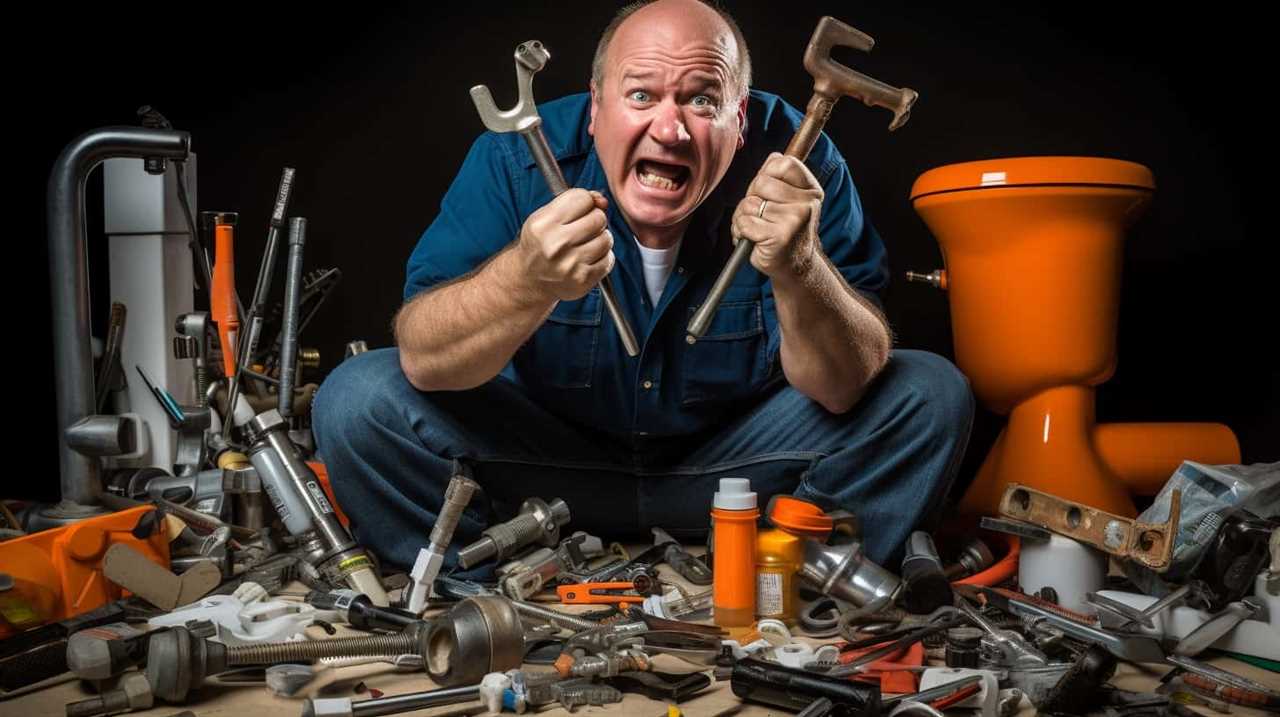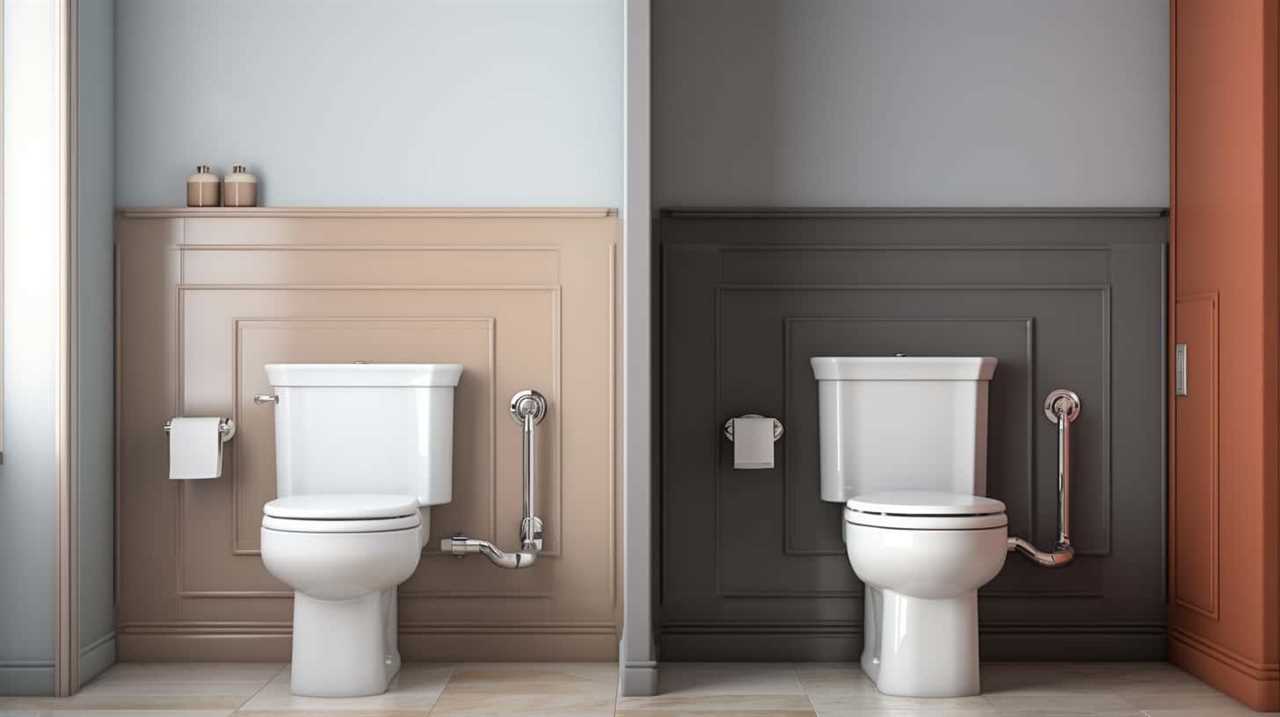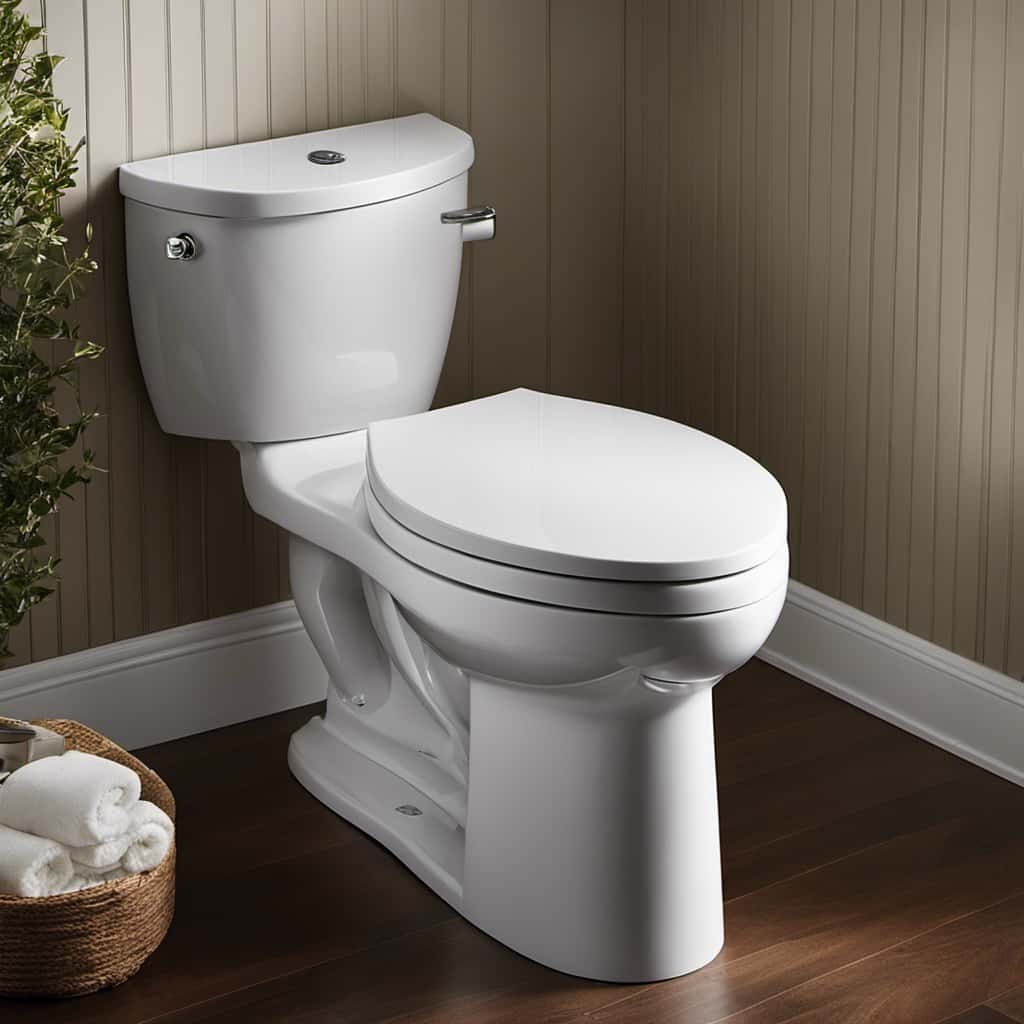Fed up with a toilet flush handle that’s either too sticky or too loose? Worry not! This article is your guide to understanding the typical problems associated with toilet flush handles and offering you effective solutions.
From fixing a sticky flush handle to upgrading for better performance, I will share troubleshooting tips and maintenance techniques to ensure your flush handle lasts longer.
Get ready to become a master of toilet flush handle mastery!
Key Takeaways
- Loose or wobbly handle can be fixed by tightening the mounting nut or inspecting the handle for damage
- Buildup of mineral deposits or faulty spring may cause a stuck or non-returning handle
- DIY repairs can save money by following manufacturer’s instructions and turning off the water supply
- Upgrading to a more durable and efficient flush handle can improve flushing performance
Common Issues With Toilet Flush Handles
I often encounter common issues with toilet flush handles. One of the most common problems is when the handle becomes loose or wobbly. This can be caused by a worn or broken lever arm, which connects the handle to the flushing mechanism.

To fix this issue, you can try tightening the mounting nut located inside the toilet tank. If this doesn’t work, you may need to replace the entire flush handle assembly.
Another common issue is when the handle gets stuck or doesn’t return to its original position after flushing. This can be caused by a buildup of mineral deposits or a faulty spring.
In this case, you can try cleaning the handle and the mechanism with vinegar or a descaling solution. If that doesn’t work, it may be necessary to replace the flush handle altogether.
DIY flush handle repair is relatively simple and can save you money on a plumber. Just make sure to turn off the water supply and follow the manufacturer’s instructions carefully when replacing the handle.

How to Fix a Sticky Flush Handle
When dealing with a sticky flush handle, it’s important to determine the cause of the issue before attempting any repairs. Here are some steps to follow in order to fix a sticky flush handle:
- First, locate the handle’s mounting nut inside the tank.
- Use a wrench to tighten the nut if the handle feels loose.
If the handle is still sticking, remove the mounting nut and inspect the handle for any signs of damage or wear. If the handle is broken, it will need to be replaced. Purchase a new handle that matches your toilet model. Install the new handle by sliding it through the mounting hole and securing it with the mounting nut.
Upgrading Your Flush Handle for Better Performance
To improve the performance of your toilet’s flush handle, consider upgrading it to a more durable and efficient option.
There are several flush handle alternatives available on the market that offer benefits over traditional handles. A high-quality flush handle can provide a smoother and more reliable flushing experience, reducing the need for multiple flushes and minimizing the chance of clogs.

These handles are often made from sturdy materials such as metal or high-grade plastic, ensuring longevity and resistance to wear and tear. Additionally, some upgraded flush handles feature ergonomic designs that provide a comfortable grip and easy operation.
Troubleshooting Tips for a Loose Flush Handle
If you’re experiencing a loose flush handle, it can be quite frustrating when trying to operate your toilet efficiently. Luckily, there are a few troubleshooting tips you can try before resorting to replacing the flush handle. Here are some common causes of a loose handle and steps to fix the problem:
- Loose mounting nut: Use a wrench to tighten the nut connecting the handle to the toilet tank.
- Broken handle arm: Remove the handle and inspect the arm for any cracks or damage. If necessary, replace the arm with a new one.
- Worn-out handle mechanism: Disassemble the handle mechanism and look for any worn or broken parts. Replace any damaged components.
- Incorrect handle installation: Make sure the handle is installed correctly according to the manufacturer’s instructions.
- Damaged toilet tank: If all else fails, the issue may lie with the toilet tank itself. Consider contacting a professional plumber to assess and repair the tank.
Maintaining and Extending the Lifespan of Your Flush Handle
One important way to maintain and extend the lifespan of your flush handle is by regularly cleaning and lubricating it. Proper cleaning techniques for toilet flush handles depend on the material used in their construction.
Flush handles are commonly made from materials such as plastic, metal, or stainless steel. For plastic handles, mild soap and water can be used to clean off any dirt or grime. Avoid using abrasive cleaners or scrub brushes that may scratch the surface.

Metal or stainless steel handles can be cleaned with a non-abrasive cleaner and a soft cloth. After cleaning, it’s important to lubricate the moving parts of the flush handle to ensure smooth operation. Apply a small amount of silicone-based lubricant to the pivot point, lever, and any other moving parts.
Regular cleaning and lubrication will help prevent corrosion, maintain functionality, and extend the lifespan of your flush handle.
Frequently Asked Questions
How Do I Choose the Right Flush Handle for My Toilet?
To choose the right flush handle for your toilet, consider the different types of toilet handles available. Once you have selected the appropriate handle, follow the instructions to install it properly.
Can a Faulty Flush Handle Cause Water Wastage?
Yes, a faulty flush handle can cause water wastage. When the handle doesn’t properly engage the flushing mechanism, it can result in continuous water flow, leading to unnecessary water consumption. This has a negative environmental impact and should be addressed promptly.

Is It Possible to Upgrade a Flush Handle on a Dual-Flush Toilet?
Yes, it is possible to upgrade the flush handle on a dual-flush toilet. There are various upgrade options available that can enhance the functionality and efficiency of the toilet. Upgrading the handle can provide benefits such as improved water conservation and ease of use.
Can a Loose Flush Handle Lead to Toilet Leaks?
Yes, a loose flush handle can lead to toilet leaks. When the handle is loose, it can cause the flush valve to not properly seal, resulting in water continuously flowing into the bowl.
Are There Any Alternative Options to Traditional Flush Handles Available in the Market?
There are alternative options available in the market for toilet flush handles. These include automatic flush mechanisms and decorative flush handle options. They offer convenience and aesthetic appeal to enhance the overall toilet experience.
Conclusion
In conclusion, maintaining and upgrading your toilet flush handle can greatly improve its performance and extend its lifespan. By fixing sticky handles and troubleshooting loose ones, you can ensure smooth flushing every time.

Additionally, upgrading to a high-quality flush handle can provide better durability and convenience. Did you know that a study found that 25% of households experience issues with their toilet flush handles?
Taking care of this small but essential component can save you from potential plumbing problems in the future.










